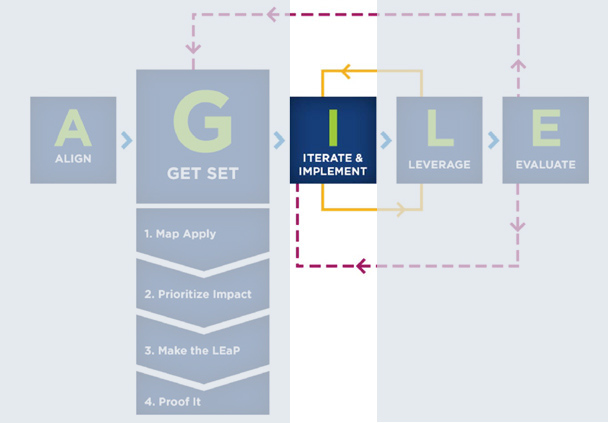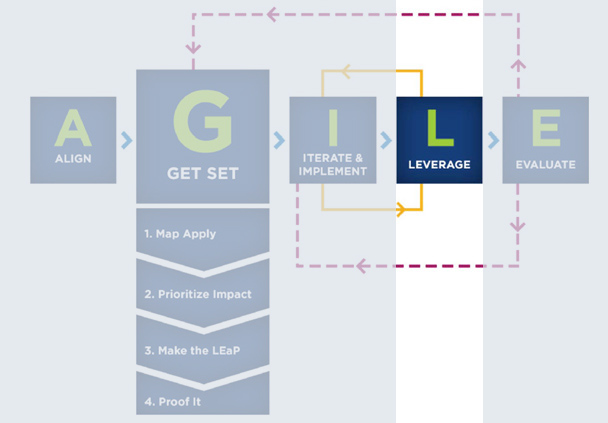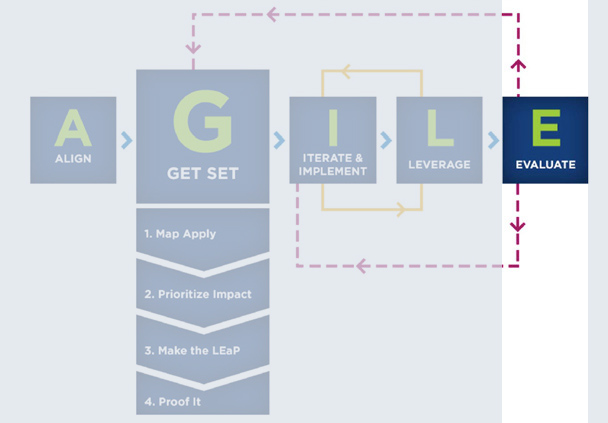If you’ve read the other two articles in this series, then you know Conrad Gottfredson developed the A.G.I.L.E. instructional design methodology to empower learning teams to create and deploy a core learning solution, with a complementary performance support system, more rapidly. You also know the first two steps in the methodology , align and get set, are key to identifying and validating business performance needs and defining requirements for learning and performance interventions. To complete the series, we’ll wrap-up the get set step and discuss the final three steps of A.G.I.L.E. instructional design.
Making the LEaP
The final two activities of the get set step are make the LEaP and proof it. Here, Gottfredson explains, the focus is on developing a learning experience and performance (LEaP) plan and proofing your EPSS (embedded performance support system).
According to Gottfredson, the LEaP plan “provides the information you need to determine the development requirements of the project and set the stage for iterative development.” In essence, the LEaP plan allows you to create blended solutions at the task level, thereby ensuring your learners have the support they need, when they need it. He advises completing a LEaP plan when the complexity of a project is medium or above and:
- You will be supporting the release of a new software system; and/or
- The project scope includes multiple processes with new development and/or brokering requirements for multiple types of reference, learning, and people resources; and
- The impact of failure ratings (from the critical skills analysis) justifies developing a blended solution that will sustain performers in all five moments of need.
 Figure 1: Conrad
Gottfredson advises using a LEaP plan to evaluate the range of options you want
to consider for each of the tasks and associated concepts identified during the
rapid task analysis
Figure 1: Conrad
Gottfredson advises using a LEaP plan to evaluate the range of options you want
to consider for each of the tasks and associated concepts identified during the
rapid task analysis
Entire volumes have been and could be written about the power of an EPSS, so for the sake of brevity, consider Gottfredson’s four basic tasks for designing an EPSS:
- Develop a workflow map, to help performers manage cognitive load with a visual mental model
- Define and populate the EPSS pyramid, to align all the reference, learning, and people resources that performers need in the workflow process at any moment of need
- Determine key contexts; to identify times when performers need access to information specific to their unique roles or access completely outside the workflow
- Establish the overarching EPSS structure, to determine access paths for tasks and other reference assets and to design landing pages (ensuring every page contributes value!)
Step three: Iterate and implement
With the LEaP plan complete and prioritization determined, you can now begin to develop solutions iteratively and implement them incrementally. The focus of the first iteration must be a functionally successful solution.
It is here that we clearly see the power of A.G.I.L.E. instructional design to keep up with agile software development. As Gottfredson explains, the learning team can use each user story defined by the software development team to:
- Determine how the functionality described in the user story will directly impact user performance
- Determine if the current understanding of users will need to change, or if it requires the identification of one or more new supporting knowledge topics
- Map the changes to the existing LEaP Plan
 Figure 2: The
third step in A.G.I.L.E. instructional design is iterate and implement
Figure 2: The
third step in A.G.I.L.E. instructional design is iterate and implement
Step four: Leverage
Gottfredson acknowledges, “Organizations can’t achieve a sustained pattern of effective performance in an environment of continuous change unless they put into place the means to deliver to every employee just what is needed, in the way it’s needed, to support effective performance.” The fourth step in A.G.I.L.E. instructional design allows learning teams to leverage technology, people, and research to deliver effective performance support.
 Figure 3: The fourth step in A.G.I.L.E.
instructional design is leverage
Figure 3: The fourth step in A.G.I.L.E.
instructional design is leverage
By leveraging technology, Gottfredson explains that learning teams can build performance support architecture that:
- Provides immediate workflow access in two clicks or 10 seconds
- Brokers scattered resources, making them contextually available to performers when and where they need them
- Keeps information current through single-source publishing
- Manages the functionality within and across all performance-support solutions
Leveraging people allows learning teams to evaluate social learning and social media engagement and virtual collaboration within their organizations. And finally, leveraging research challenges learning teams to remain up-to-date and fluent in principles ranging from encoding to experiential learning, from spaced learning to managing cognitive load, and from adaptive response to automaticity—all the while ensuring you provide effective performance support at the moment of need.
Step five: Evaluate
Lastly, the final step in A.G.I.L.E. instructional design, as with the ADDIE model, is evaluate. “Effective evaluation improves the quality of what we do, increases the efficiency in how we do it, determines the degree to which we can consistently achieve what we set out to do, and measures the strategic value of it all. Performance support plays a vital role in enabling all of this,” says Gottfredson.
 Figure 4: The final step in A.G.I.L.E.
instructional design is evaluate
Figure 4: The final step in A.G.I.L.E.
instructional design is evaluate
In the final step of A.G.I.L.E. instructional design, evaluate, Gottfredson advises learning teams to develop a measurement strategy and put in place a measurement infrastructure. To develop the strategy and actively measure the business impact of what we do, he suggests integrating a true performance-support solution and linking training to the business impact. Finally, as Gottfredson explains, building a measurement infrastructure is predicated upon a few guiding principles:
- Conduct both formative (that which occurs during the development process to help you improve what you are developing) and summative evaluation (a summary evaluation that helps you make a judgment of the merit or worth of what you have developed).
- Understand the strengths and limits of self-perception.
- Triangulate your conclusions by gathering information from multiple sources.
- Create valid and reliable measurement tools.
- And, never lose sight of your purposes. “You should continually check everything you do during formative and summative evaluation against the purpose or mission of that evaluation,” says Gottfredson.
The final word
As this journey to learn more about A.G.I.L.E. instructional design commenced, I was lured by the opportunity to add a new methodology to my ever-expanding toolbox. After spending the last several weeks mired in the details of the process, I’ve walked away with confirmation that procedural-based topics and software-development projects easily lend themselves to such an approach, while other principle- or knowledge-based topics may not always require as much rigor to ensure effective on-the-job performance.
As Gottfredson admits, “The practices within A.G.I.L.E. instructional design are highly structured. While the ADDIE model provides a framework, the way instructional designers approach each step may be highly variant. But that is not the case with A.G.I.L.E. instructional design.” It is this structure, however, that allows designers to design for the entire learning ecosystem, rather than focusing on learning alone. A.G.I.L.E. instructional design can address all that needs to be developed for formal learning—learn new and learn more—while also accommodating the remaining three moments of need—apply, change, and solve. “This broader development effort can be met within the same time and effort footprint of traditional training development. With A.G.I.L.E. instructional design, we end up reducing ‘formal learning time’ by as much as 50 percent, and we speed up other aspects of development,” explains Gottfredson.
Designers should also be aware that the SMEs involved early in the process—especially in the align step—should be the process owners or business sponsors who can really help define the strategy and scope and validate business-performance needs. Then, in subsequent steps and activities, you can engage other individuals as technical SMEs on the project team.
As we embark on a new year, we should all take a moment to reflect on the thought leaders in our field working tirelessly to create and promote ideas and models that ultimately advance our profession and challenge us to think in new and different ways about our work. And as you set goals for the coming year, I personally encourage you to take advantage of opportunities to learn more about how you can best support your learners and ensure you continue to design, develop, and deliver the most effective learning and performance support solutions possible.


